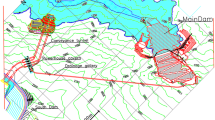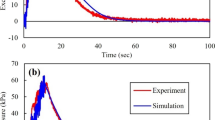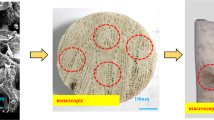Abstract
This paper examines the influence of porous media deformation on water-table wave dispersion in an unconfined aquifer using a numerical model which couples Richards’ equation to the poro-elastic model. The study was motivated by the findings of Shoushtari et al. (J Hydrol 533:412–440, 2016) who were unable to reproduce the observed wave dispersion in their sand flume data with either numerical Richards’ equation models (assuming rigid porous media) or existing analytic solutions. The water-table wave dispersion is quantified via the complex wave number extracted from the predicted amplitude and phase profiles. A sensitivity analysis was performed to establish the influence of the main parameters in the poro-elastic model, namely Young’s modulus (E) and Poisson’s ratio (ν). For a short oscillation period (T = 16.4 s), the phase lag increase rate (k i) is sensitive to the chosen values of E and ν, demonstrating an inverse relationship with both parameters. Changes in the amplitude decay rate (k r), however, were negligible. For a longer oscillation period (T = 908.6 s), variations in the values of E and ν resulted in only small changes in both k r and k i. In both the short and long period cases, the poro-elastic model is unable to reproduce the observed wave dispersion in the existing laboratory data. Hence porous media deformation cannot explain the additional energy dissipation in the laboratory data. Shoushtari SMH, Cartwright N, Perrochet P, Nielsen P (2016) The effects of oscillation period on groundwater wave dispersion in a sandy unconfined aquifer: sand flume experiments and modelling. J Hydrol 533:412–440.
Résumé
Cet article examine l’influence de la déformation du milieu poreux sur la dispersion des ondes de la surface piézométrique dans un aquifère sableux libre en utilisant un modèle numérique qui couple l’équation de Richard avec un modèle poro-élastique. Cette étude était motivée par les résultats de Shoushtari et al. (2016) qui n’étaient pas capables de reproduire la dispersion des ondes observées dans des données issues d’un réservoir à sable, tant avec des modèles numériques de l’équation de Richard (faisant l’hypothèse d’un milieu poreux rigide) qu’avec des solutions analytiques existantes. La dispersion des ondes de la surface piézométrique est quantifiée par un nombre d’onde complexe extrait de profils d’amplitude et de phase prédits. Une analyse de sensibilité a été réalisée afin d’évaluer l’influence des principaux paramètres dans le modèle poro-élastique, à savoir le module de Young (E) et le coefficient de Poisson (ν). Pour une courte période d’oscillation (T = 16.4 s), le taux d’accroissement du retard de phase (k i) est sensible aux valeurs retenues pour E et ν, ce qui démontre une relation inverse avec les deux paramètres. Les modifications de l’amplitude du taux de décroissance (k r) sont cependant négligeables. Pour une période d’oscillation plus longue (T = 908.6 s), des variations des valeurs de E et ν ont seulement induit de faibles changements tant de k r que de k i. Dans les deux cas de courte et de longue périodes, le modèle poro-élastique est incapable de reproduire la dispersion des ondes observée dans les données existantes en laboratoire. Par conséquent, la déformation du milieu poreux ne peut pas expliquer la dissipation d’énergie additionnelle dans les données obtenues au laboratoire. Shoushtari SMH, Cartwright N, Perrochet P, Nielsen P (2016) The effects of oscillation period on groundwater wave dispersion in a sandy unconfined aquifer: sand flume experiments and modelling. J Hydrol 533:412–440.
Resumen
En este trabajo se analiza la influencia de la deformación de medios porosos en la dispersión de ondas de la capa freática en un acuífero no confinado mediante un modelo numérico que acopla la ecuación de Richards con el modelo poro-elástico. El estudio fue motivado por los hallazgos de Shoushtari et al. (2016) que fueron incapaces de reproducir la dispersión de las ondas observadas en los datos de un canal de arena, tanto con modelos numéricos de la ecuación de Richards (suponiendo un medio poroso rígido) como con las soluciones analíticas existentes. La dispersión de las ondas de la capa freática se cuantifica a través del número de onda complejo extraído de los perfiles de fase y amplitud predichos. Se realizó un análisis de sensibilidad para establecer la influencia de los parámetros principales en el modelo de poro-elástico, a saber, el módulo de Young (E) y el coeficiente de Poisson (ν). Durante un periodo de oscilación corto (T = 16.4 s), el ritmo de incremento del retardo de fase (k i) es sensible a los valores elegidos para E y ν, demostrándose una relación inversa con ambos parámetros. Sin embargo, los cambios en el ritmo de decaimiento de la amplitud (k r), fueron despreciables. Para un período más largo de oscilación (T = 908.6 s), las variaciones en los valores de E y ν resultaron en sólo en pequeños cambios tanto en k r como en k i. En los dos casos período corto y largo, el modelo de poro-elástico es incapaz de reproducir la dispersión observada de la onda en los datos de laboratorio existentes. Por lo tanto la deformación de un medio poroso no puede explicar la disipación de energía adicional en los datos de laboratorio. Shoushtari SMH, Cartwright N, Perrochet P, Nielsen P (2016) The effects of oscillation period on groundwater wave dispersion in a sandy unconfined aquifer: sand flume experiments and modelling. J Hydrol 533:412–440.
摘要
本文利用把Richards方程式与多孔--弹性模型耦合的数值模型检查了非承压含水层多孔介质变形对水位波弥散的影响。受到Shoushtari等人(2016)的研究结果激发而进行了这项研究,Shoushtari等人采用数值Richards方程式模型(假设为严格的多孔介质)或现有的解析方法在砂槽数据中并不能再现观测到波弥散。通过从预测的幅相剖面提取的复合的波数量化了水位波弥散。进行了灵敏度分析,建立了多孔—弹性模型中主要参数的影响,即杨氏模量(E)和泊松比(v)。对于很短的振荡周期(T = 16.4 s),相位滞后增长率(k i)对所选的E 值和ν的值非常敏感,显示出了与两个参数的逆相关。然而,振幅衰退率(k r)变化可以忽略不计。对于较长的振荡周期(T = 908.6 s),E 值和ν值的变化只造成了k r and k i.很小的变化。在短期和长期情况下,多孔—弹性模型不能在现有的实验数据中再现 观测到的波弥散。因此,多孔介质变形不能解释实验数据中的额额外的能量耗散。Shoushtari SMH, Cartwright N, Perrochet P, Nielsen P (2016) The effects of oscillation period on groundwater wave dispersion in a sandy unconfined aquifer: sand flume experiments and modelling [(振荡周期对砂质飞承压含水层地下水波弥散的影响:砂槽实验和模拟]. J Hydrol 533:412–440.
Resumo
Este artigo examina a influência da deformação do meio poroso na dispersão da oscilação do nível freático em um aquífero livre utilizando um modelo numérico que acoplou a equação de Richard ao modelo poro-elástico. O estudo foi motivado pelas descobertas de Shoushtari et al. (2016) que foram incapazes de reproduzir a dispersão da oscilação de dispersão observada na informação da calha de areia tanto com modelos numéricos de Richard (assumindo meio poroso rígido) quanto soluções analíticas existentes. A dispersão da oscilação do nível freático é quantificada pelo complexo número de oscilações extraídas da amplitude predita e fase do perfil. Uma análise da sensibilidade foi realizada para estabelecer a influência dos parâmetros principais no modelo poro-elástico, designado modulo de Young (E) e razão de Poisson (v). Para um curto período de oscilação (T = 16.4 s), o aumento da taxa atraso de atraso da fase (k i) é sensível a valores escolhidos de E e v, demonstrando uma relação inversa com ambos os parâmetros. Mudanças na taxa de decaimento da amplitude (k r), no entanto, foram insignificantes. Para um longo período de oscilação (T = 908.6 s), variações nos valores de E e v resultaram apenas em pequenas mudanças em ambos k r e k i.Em ambos os casos, curtos ou longos períodos, o modelo poro-elástico foi incapaz de reproduzir a dispersão da oscilação observada em dados existentes de laboratório. Consequentemente a deformação no meio poroso não pode explicar a energia de dissipação adicional nos dados laboratoriais. Shoushtari SMH, Cartwright N, Perrochet P, Nielsen P (2016) The effects of oscillation period on groundwater wave dispersion in a sandy unconfined aquifer: sand flume experiments and modelling [Os efeitos do período de oscilação na dispersão da oscilação das águas subterrâneas em um aquífero livre arenoso: experimentos e modelagem em calha de areia]. J Hydrol 533:412–440.





Similar content being viewed by others
References
Bakhtyar R, Brovelli A, Barry DA, Li L (2011) Wave-induced water table fluctuations, sediment transport and beach profile change: modeling and comparison with large-scale laboratory experiments. Coast Eng 58(1):103–118. doi:10.1016/j.coastaleng.2010.08.004
Barry DA, Barry SJ, Parlange J-Y (1996) Capillarity correction to periodic solutions of the shallow flow approximation. In: Pattiaratchi CB (ed) Mixing in estuaries and coastal seas, coastal and estuarine studies. AGU, Washington, DC, pp 496–510
Biot MA (1941) General theory of three-dimensional consolidation. J Appl Phys 26(2):155–164
Biot MA (1955) Theory of elasticity and consolidation for a porous anisotropic solid. J Appl Phys 26:182–185
Biot MA (1962) Mechanics of deformation and acoustic propagation in porous media. J Appl Phys 33:1482–1498
Cartwright N, Nielsen P, Dunn SL (2003) Water table waves in an unconfined aquifer: experiments and modeling. Water Resour Res 39:1330–1342
Cha DH, Jeng D-S, Rahman MS, Sekiguchi H, Zen K, Yamazaki H (2002) Effects of dynamic soil behavior on the wave-induced seabed response. Int J Ocean Eng Technol 16(5):21–33
Chui TFM, Freyberg DL (2009) Implementing hydrologic boundary conditions in a multiphysics model. Hydrol Eng 14(12):1374–1377
COMSOL (2013) COMSOL multiphysics reference manual version 4.3b. COSMOL, Burlington, MA, 1664 pp
Elfrink B, Baldock TE (2002) Hydrodynamics and sediment transport in the swash zone: a review and perspectives. Coast Eng 45(3):149–167
Jeng D-S (2003) Wave-induced seafloor dynamics. Appl Mech Rev 56(4):407–429
Jeng D-S, Cha DH (2003) Effects of dynamic soil behavior and wave nonlinearity on the wave induced pore pressure and effective stresses in porous seabed. Ocean Eng 30:2065–2089
Jeng D-S, Hsu JRC (1996) Wave-induced soil response in a nearly saturated seabed of finite thickness. Geotechnique 46:427–440
Jeng D-S, Lin YS (1996) Finite element modelling for water waves–soil interaction. Soil Dyn Earthq Eng 15(5):283–300
Jeng D-S, Lin YS (1997) Non-linear wave-induced response of porous seabed: a finite element analysis. Int J Numer Anal Methods Geomech 21(1):15–42
Kong J, Shen C-J, Xin P, Song Z, Li L, Barry DA, Jeng DS, Stagnitti F, Lockington DA, Parlange J-Y (2013) Capillary effect on water table fluctuations in unconfined aquifers. Water Resour Res 49(5):3064–3069. doi:10.1002/wrcr.20237
Li L, Barry DA, Stagnitti F, Parlange J-Y (1999) Submarine groundwater discharge and associated chemical input to a coastal sea. Water Resour Res 35:3253–3259
Li L, Barry DA, Stagnitti F, Parlange J-Y (2000) Groundwater waves in a coastal aquifer: a new governing equation including vertical effects and capillarity. Water Resour Res 36(2):411–420
Madsen OS (1978) Wave-induced pore pressure and effective stresses in porous bed. Geotechnique 28(4):377–393
Mei CC, Foda MA (1981) Wave-induced responses in a fluid-filled poro-elastic solid with a free surface: a boundary layer theory. Geophys J R Astro Soc 66:591–637
Nielsen P (1990) Tidal dynamics of the water table in beaches. Water Resour Res 26(9):2127–2134
Nielsen P, Perrochet P (2000a) Watertable dynamics under capillary fringes: experiments and modelling. Adv Water Resour 23(5):503–515
Nielsen P, Perrochet P (2000b) ERRATA: watertable dynamics under capillary fringes: experiments and modelling [Advances in Water Resources 23 (2000) 503–515]. Adv Water Resour 23(8):907–908
Nielsen P, Aseervatham AM, Fenton JD, Perrochet P (1997) Groundwater waves in aquifers of intermediate depths. Adv Water Resour 20(1):37–43
Okusa S (1985) Wave-induced stresses in unsaturated submarine sediments. Geotechnique 35(4):517–532
Rahman MS, El-Zahaby K, Booker J (1994) A semi-analytical method for the wave induced seabed response. Int J Numer Anal Methods Geomech 18:213–236
Richards LA (1931) Capillary conduction of liquids through porous mediums. Physics 1(5):318–333
Robinson C, Gibbes B, Li L (2006) Driving mechanisms for groundwater flow and salt transport in a subterranean estuary. Geophys Res Lett 33(L03402). doi:10.1029/2005GL025247
Shabani B, Jeng D-S, Small J (2009) Wave-associated seabed behaviour near submarine buried pipelines. Nova, New York, pp 3–109
Shoushtari SMHJ, Nielsen P, Cartwright N, Perrochet P (2015a) Periodic seepage face formation and water pressure distribution along a vertical boundary of an aquifer. J Hydrol 523:24–33. doi:10.1016/j.jhydrol.2015.01.027
Shoushtari SMH, Cartwright N, Perrochet P, Nielsen P (2015b) Influence of hysteresis on groundwater wave dynamics in an unconfined aquifer with a sloping boundary. J Hydrol 531(3):1114–1121. doi:10.1016/j.jhydrol.2015.11.020
Shoushtari SMH, Cartwright N, Perrochet P, Nielsen P (2016) The effects of oscillation period on groundwater wave dispersion in a sandy unconfined aquifer: sand flume experiments and modelling. J Hydrol 533:412–440. doi:10.1016/j.jhydrol.2015.12.032
Thomas SD (1989) A finite element model for the analysis of wave induced stresses, displacements and pore pressure in an unsaturated seabed, I: theory. Comput Geotech 8(1):1–38
Thomas SD (1995) A finite element model for the analysis of wave induced stresses, displacements and pore pressure in an unsaturated seabed, II: model verification. Comput Geotech 17(1):107–132
van Genuchten MT (1980) A closed form equation for predicting the hydraulic conductivity of unsaturated soils. Soil Sci Soc Am J 44:892–898
Xin P, Robinson C, Li L, Barry DA, Bakhtyar R (2010) Effects of wave forcing on a subterranean estuary. Water Resour Res 46(W12505). doi:10.1029/2010WR009632
Yamamoto T (1981) Wave-induced pore pressure and effective stresses in homogeneous seabed foundations. J Ocean Eng 8:1–16
Yamamoto T, Schuckman B (1984) Experiments and theory of wave–soil interactions. J Eng Mech ASCE 110(1):95–112
Yamamotom T, Koning HL, Sellmeijer H, von Hijum E (1978) On the response of a poro-elastic bed to water waves. J Fluid Mech 87(1):193–206
Zhang X, Jeng D-S, Luan MT (2011a) Dynamic response of a porous seabed around pipeline under three-dimensional wave loading. Soil Dyn Earthq Eng 31(5–6):785–791
Zhang J-S, Jeng D-S, Liu PL-F (2011b) Numerical study for waves propagating over a porous seabed around a submerged permeable breakwater PORO-WSSI II model. Ocean Eng 38(7):954–966
Zienkiewicz OC, Chang CT, Bettess P (1980) Drained, undrained, consolidating and dynamic behavior assumptions in soils. Geotechnique 30(4):385–395
Acknowledgements
The first author has been supported by Griffith University International Postgraduate Research Scholarship (GUIPRS) and Griffith University Postgraduate Research Scholarship (GUPRS). The authors also acknowledge the valuable comments received during the review process.
Author information
Authors and Affiliations
Corresponding author
Rights and permissions
About this article
Cite this article
Jazayeri Shoushtari, S.M.H., Cartwright, N. Modelling the effects of porous media deformation on the propagation of water-table waves in a sandy unconfined aquifer. Hydrogeol J 25, 287–295 (2017). https://doi.org/10.1007/s10040-016-1487-7
Received:
Accepted:
Published:
Issue Date:
DOI: https://doi.org/10.1007/s10040-016-1487-7




